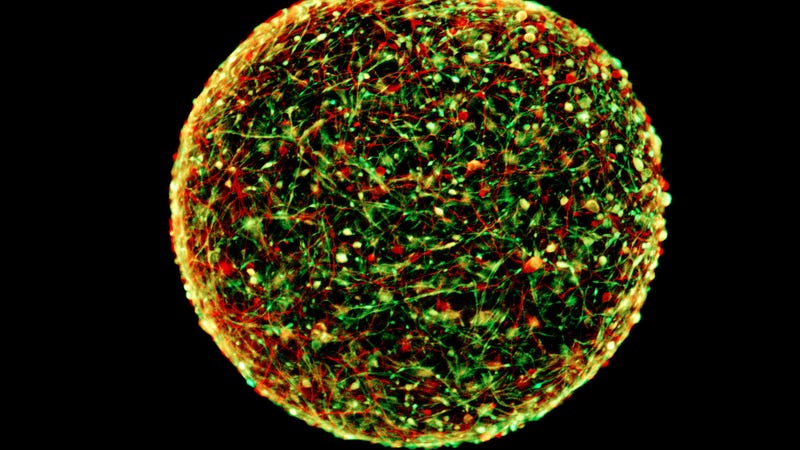New ‘Mini-Brains’ Could Put Thousands of Lab Animals Out of Work
 Credit: Thomas Hartung/CAAT
Credit: Thomas Hartung/CAAT
Researchers at Johns Hopkins Bloomberg School of Public Health have produced tiny brains made of human neurons and cells. These mini-brains could radically change how drugs are tested, replacing the many animals currently being used for neurological scientific research.
These mini-brains may be small—about the size of a common housefly—but they still exhibit characteristics typical of the real thing. Made from adult human stem cells, these brains aren’t capable of conscious thought or cognition, nor are they capable of experiencing pain or suffering. They can also be mass produced, and they’re standardized, so they’re ideal for lab experiments requiring biologically active brains.
Also known as organoids, the balls of human brain cells are more ethical, and possibly even better, than lab animals, including rats and mice. This work is being presented today at a meeting of the American Association for the Advancement of Science conference in Washington, D.C.
Reducing the amount of animal experimentation that goes on is more than a matter of ethics, there’s also the quality of the science itself to consider. Animals, even when genetically modified, make for poor models of human diseases, particularly those of a neurological nature. As a 2006 study in JAMA pointed out, “patients and physicians should remain cautious about extrapolating the findings of prominent animal research to the care of human disease,” adding that “even high-quality animal studies will replicate poorly in human clinical research.”
It’s a sentiment that’s not lost on Thomas Hartung, a molecular biologist who works out of the Center for Alternatives to Animal Testing (CAAT) at Johns Hopkins, and lead developer of the mini-brain project.
“We are not 150 pound rats,” he told Gizmodo. “Lab animals tend to be young, healthy, identical twins, [and] get a standardized environment and food. Rats live for two years—why should evolution worry about degenerative brain diseases?”
Hartung believes that no scientist should have to use animals just because it’s too complicated to get the alternative to work. That’s why he’s building the mini-brain, one of several exciting high-tech solutions that could change the way scientists do research and testing.
To create the mini-brains, Hartung’s team coaxed genetically reprogrammed pluripotent stem cells into becoming brain cells. “We used no embryonic stem cells, but those reprogrammed from skin,” he said. “This avoids not only ethical conflicts, it also allows us to take them from patients with a disease.”
By taking cells from a patient with a particular genetic disorder, the researchers can create a mini-brain based around the genetic profile that contributed to the disease. The resulting organoids would model certain neurological disorders, which could be used in drug testing. Trials to study viral infections, trauma, and stroke have already begun.
It only takes about eight weeks to grow the mini-brains, and hundreds of thousands of exact copies can be produced in each batch. As many as 100 can be grown in the same petri dish.
These balls of brain cells do things that normal brains do. They have four types of neurons and two types of support cells, namely astrocytes and oligodendrocytes, the latter of which is responsible for the creation of myelin, a sheath that’s essential for healthy nervous system functioning. The lab-grown mini-brains even exhibited spontaneous electrophysical activity, which was recorded with a measuring device similar to the way EEG works.
Using an array of electrodes, the researchers were able to study how the neurons reacted to certain drugs. Hartung told Gizmodo that the spontaneous elctrophysiological intercellular communication and myelination of axons had never been observed before.
Other similar mini-brains exist, but Hartung’s is the most standardized—an important factor when testing drugs.
“There are a handful of such models described over the last two years,” he said. “They show more fancy brain structures, but each and every one looks different, often with cells in the middle dying because of lack of oxygen as they have no blood vessels. We produce hundreds of identical mini-brains, every week. This is critical for testing and comparing substances. They have exactly the same size below a critical diameter.”
Hartung wants these models to be readily accessible. He’s applying for a patent on the mini-brains, and he’s also got a commercial venture called ORGANOME in the works. Ideally, a researcher would be able to order the mini-brains online and have them delivered by parcel service within a week. And by using a commercial entity rather than academic channels, he’s hoping to make it all happen this year.
Written by: George Dvorsky
Source: http://gizmodo.com/new-mini-brains-could-put-thousands-of-lab-animals-ou-1758736211?utm_campaign=socialflow_gizmodo_facebook&utm_source=gizmodo_facebook&utm_medium=socialflow
